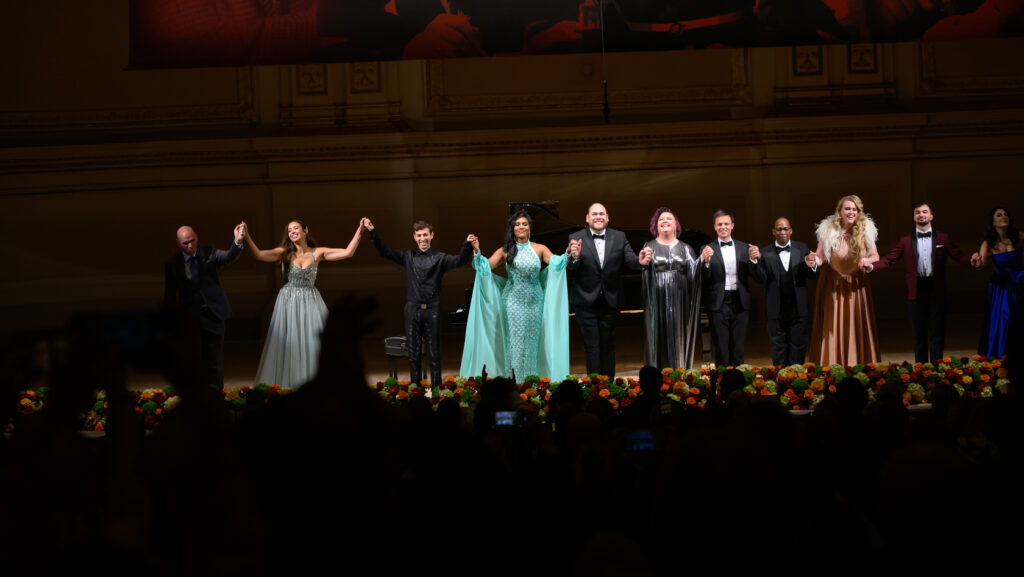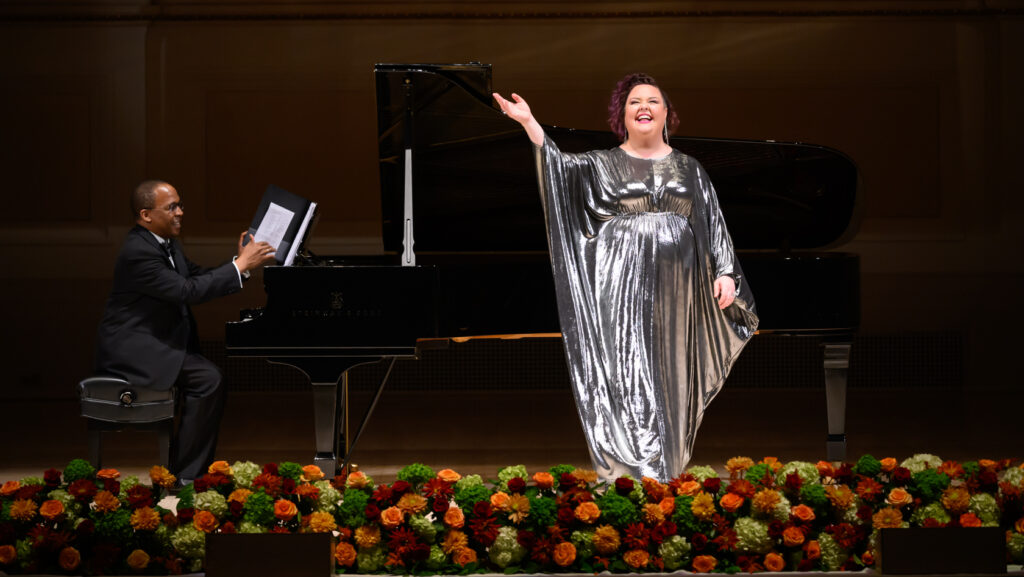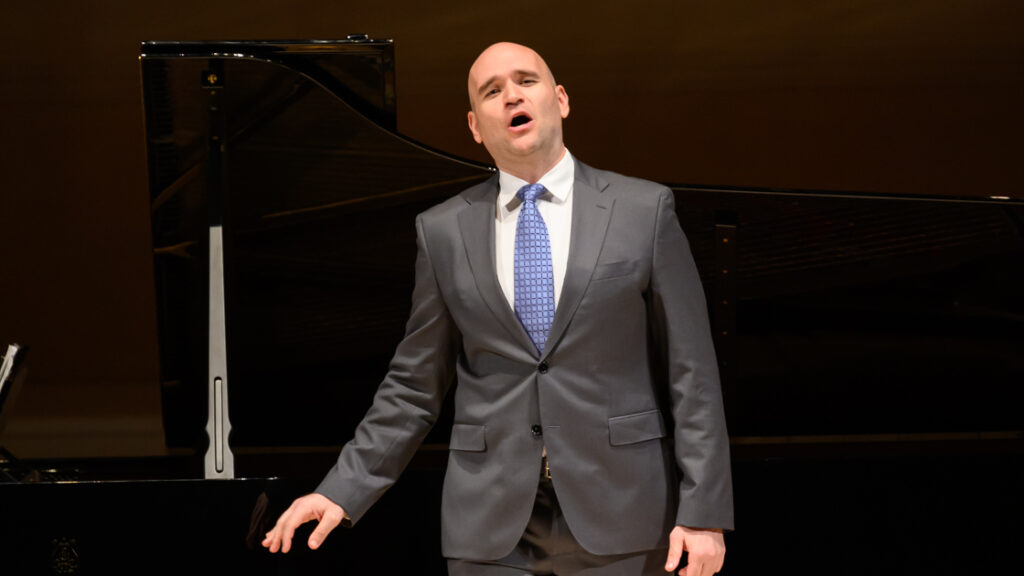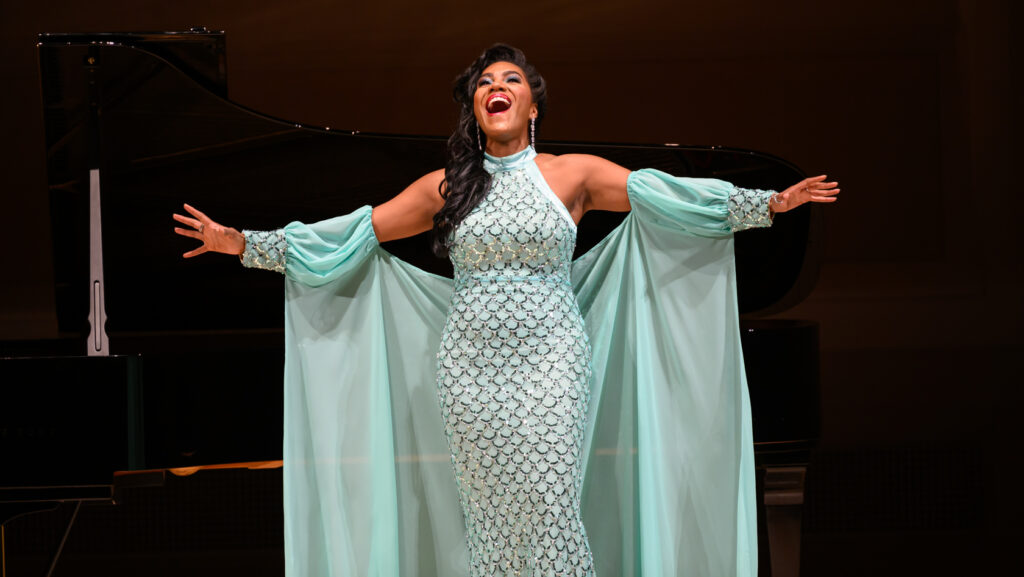

The Foundation has kept itself afloat unlike several other operatic institutions and presented their annual gala at Carnegie Hall on Sunday evening, October 27, 2024. As they did last year, there was no orchestra just piano accompaniment, which takes a lot of the gala out of the gala. This year, the Foundation did award a Richard Tucker Award Winner, as usual, to someone who is already well-established and successful in the opera world: the heldentenor Clay Hilley. Hilley conquered Bayreuth in the summer of 2022 as a last-minute replacement Siegfried for Andreas Schager. He returned this summer as Tristan. Unfortunately, Hilley was already booked in Berlin (as is natural for a now international star tenor who no longer needs prizes) and was unable to participate in the gala.
The real value of the Tucker Foundation lies in its Study and Career grants which are awarded to young singers attempting to clamber up the ladder of an operatic career. Young singers often struggle without the funding necessary to sustain themselves when training is expensive and the gigs are fewer and lower paying. That is when cash prizes come in handy. Several of the evening’s participants were former recipients of not only the Tucker Award, but alsothe Career and Sara Tucker Study grants.
This year the Tucker Foundation tapped (with the cooperation and assistance of Peter Gelb) the current roster of the Metropolitan Opera. (Spanish tenor Xabier Anduaga was listed in early announcements but did not appear.) Cast members of the current Met revivals of Il Trovatore, Rigoletto and Ainadamar were present and accounted for with the addition of countertenor Anthony Roth Costanzo and the rising tenor Anthony León, a 2024 Tucker Career Grant winner. The Met’s current Duke of Mantua, Stephen Costello, was indisposed and had to withdraw from the festivities. Angel Blue, who had just finished singing Margarita Xirgu in the Ainadamar Sunday afternoon matinee a few hours before, stepped in at the last minute.
The ensuing program bore little resemblance to what was printed in the playbill, which is business as usual for the Tucker Gala.
The evening kicked off with the 2017 Tucker Award Winner, Nadine Sierra, singing Mimì’s entrance aria “Sì, mi chiamano Mimì” from Puccini’s La Bohème. Sierra has not sung this role onstage as of yet, wisely feeling that Puccini’s orchestration is heavy for her voice and this fuller lyric role would impact her coloratura repertoire. This was a very external reading, though, and as always, gorgeously vocalized. The little intimate touches and conversational style eluded her seamstress along with some of the softer dynamics. Nevertheless, Sierra is full of appeal and charm all her own. It’s a good start as she moves into more grown up roles.
Her current Rigoletto at the Met, Hawaiian baritone Quinn Kelsey, replaced the scheduled Don Carlo friendship duet with Costello with a stirring, big-scaled reading of “Eri tu” from Verdi’s Un Ballo in Maschera. Kelsey’s huge, resonant, sometimes hollow-sounding baritone is better at projecting anger and intensity than softness or tenderness. These warmer tones were scarce in the second half of the aria where Renato/Anckerstrom remembers the earlier loving days of his marriage. Nonetheless, his emotional engagement and effortless projection made this scena a powerful experience.
Later on, Sierra and Kelsey returned to recreate their successful collaboration in Rigoletto this season, singing the Act II duet beginning “Parla, siam soli..” which continues with the heartbreaking “Tutte le feste al tempio” solo for Gilda. Both singers were acting and singing with total engagement, creating a deeply moving drama even in a concert setting. I now feel I must check out this cast, though I abhor the abstruse Bart Sher production.
2015 Tucker Award winner Jamie Barton swept in with the Witch’s aria “Ja Gretelchen…Hurr, hopp, hopp!” from Humperdinck’s Hänsel und Gretel. Given Barton’s youthful, lush tone, this is not the first piece I would want to hear her singing in concert. This selection provided rangy music to show off the top and bottom of her voice and ample room for her extroverted temperament and comedic verve. Rarely is this music sung as well whether by mezzo, older dramatic soprano (Anny Schlemm-style), character tenor, or baritone.
Often singers use these concerts to try out music from operas outside their current repertoire. Such was the case with the Met’s current Leonora, Rachel Willis-Sørensen, testing out Bellini’s Norma with “Casta Diva” and the “Mira o Norma” duet with Barton as Adalgisa. It’s a creamy voice with effortless legato and more than decent flexibility – her Mozart experience is helpful here.
Despite coming in a couple bars early (Bryan Wagorn on piano quickly adjusted), her smooth tone unfurled without effort and the high notes emerged seamlessly out of the vocal line. Barton’s fresh tone was better suited to the virginal junior priestess and blended well with Willis-Sørensen. Neither had the laser like high notes, trills, and 16th notes of a Sutherland and Horne, but for an erstwhile Elsa and Fricka, they did very well and sounded good. (Leonora and Azucena in Trovatore do require Italian bel canto chops.)
Their Manrico, Michael Fabiano entered slowly and effortfully from stage left after injuring his foot after “Di quella pira” in the initial Trovatore the previous afternoon. He thanked the Metropolitan Opera profusely for providing him with immediate care and attention so he could finish the performance and sending him to the hospital afterwards. The “Lamento di Federico” from L’Arlesiana was substituted with the unlikely selection of “Phidylé’ by Henri Duparc. Fabiano’s dark, muscular tenor and forthright emotional delivery is not the best medium for the delicate subtlety and vocal half-tones in French chanson. But he sang it with commitment and good French. It was an offbeat choice and I respected him for it.
Lyric coloratura soprano Elena Villalón continued in the gallic vein with the “Je marche sur tous les chemins” and “Gavotte” from the Cours-la-Reine scene from Massenet’s Manon. Villalón was full of poise and vocal elegance, unfazed by an audience that seemed unfamiliar with the piece and was applauding early between verses and sections. Her tone was lean but coolly radiant with easily attacked high notes and ornaments. A touch of class was definitely added to the evening with her performance.
Popular countertenor Anthony Roth Costanzo did not sing a selection from Handel’s Giulio Cesare as announced but a warhorse in his rep: “Stille Amare”, a largo lament from Handel’s Tolomeo.
Costanzo doesn’t always sound good in all that he attempts, both modern and baroque, but here the tone was lean but focused with a roundness and warmth from top to bottom. The darker emotions brought out from him a more complex, less blatant tonality. ARC is an intelligent emotionally engaged artist who always seems connected to the emotions of the character and music.
Currently Maddalena in the Met’s Rigoletto, mezzo-soprano J’Nai Bridges sounded darkly voluptuous limning the long intense phrases of “O ma lyre immortelle” from Gounod’s Sapho (NOT Massenet, per the program). This is the Lesbian rhymer and not the Montmartre fascinator Fanny Legrand! She also looked resplendent in a seafoam green gown with tulle cape and sequined sheath. This was a great choice of repertoire and she made the piece vibrant and exciting despite a slightly pressed final high note. Bridges also impressed with her fervent encore of “My Man’s Gone Now” from Porgy and Bess in the encores portion of the evening later on.
Newcomer Anthony León won over the crowd with a very accomplished and sweet-toned rendition of “Una furtiva lagrima” that held its own with the starrier contributions of more renowned and experienced colleagues on that stage. He returned later in the evening with the searing zarzuela aria “No puede ser” from La Tabernera del Puerto (a Domingo specialty), which confirmed the initial good impression.
Ryan Speedo Green sang “Deh, vieni alla finestra” from Don Giovanni with velvety tone and a faster tempo than often heard. His charisma and sex appeal should be a good fit for the role if he ever gets the chance to perform it here. His later encore, an a capella “Deep River,” was stirring, even more so for its modesty and simplicity.
Angel Blue entered last with a lush-toned reverent medley of an a capella “America the Beautiful” segueing into “Lady of the Harbor” by Lee Hoiby. The patriotic sentiment was sincere even as a certain presidential candidate was holding court several blocks downtown at Madison Square Garden. We need to hold on to our hard-won American values as they are in severe danger right now as a crucial election looms next week. Democracy hangs in the balance.
The encores portion was full of surprises, fun and sentimental in nature. Jamie Barton embodied warm sincerity in the Jake Heggie song “It’s You I Like.” Sierra got sentimental with a serenely radiant “Beautiful Dreamer” by Stephen Foster, dedicated to her longtime collaboration with Bryan Wagorn dating back to their student days taking masterclasses with Marilyn Horne. On the fun side of things, Anthony Roth Costanzo performed a duet with himself as soprano and baritone in “Crudel! Perché finora” from Mozart’s Le Nozze di Figaro, twirling around to perform each character. This is the sort of thing that works very well in smaller doses, as reports of his one-man Nozze from last summer would indicate. The audience laughed over the music at ARC’s antics, but it was hard not to admire his guts and clever ingenuity. Sierra and Costanzo later joined forces for a zany Gershwin “I Got Rhythm” duet which included tap dancing and ARC jumping into Sierra’s arms!
Bryan Wagorn and Howard Watkins alternated on the ivories all night, proving sensitive collaborators in a widely varied program. This was an often charming evening – intimate rather than grand with an emphasis on homegrown American local talent.
Photos: Dario Acosta





























Comments